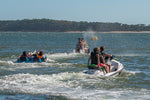
Safe and Sound: The Top Five Safety Procedures for Personal Watercraft (PWC) Riders
, by Safe Water Team, 2 min reading time

, by Safe Water Team, 2 min reading time
Personal watercraft (PWC) offer an exhilarating experience on the water, but safety should always be the top priority for riders. From wearing the right gear to following basic safety procedures, taking precautions can make all the difference in ensuring a fun and accident-free ride. In this article, we'll explore the top five safety procedures every PWC rider should follow to stay safe on the water.
Wearing a personal flotation device (PFD) is the most crucial safety precaution for PWC riders. In the event of a fall or accident, a PFD will keep you afloat and greatly reduce the risk of drowning. Choose a Coast Guard-approved PFD that fits snugly and comfortably, and wear it at all times while operating or riding on a PWC.
Before hitting the water on a PWC, it's essential to familiarize yourself with boating safety rules and regulations. Consider taking a boater safety course offered by the Coast Guard or a reputable boating organization. These courses cover essential topics such as navigation rules, PWC operation, emergency procedures, and safe boating practices, providing valuable knowledge and skills to enhance your safety on the water.
Operating a PWC requires skill, caution, and adherence to proper operation guidelines. Before setting out on the water, familiarize yourself with the owner's manual and recommended operating procedures for your specific PWC model. Pay attention to key safety features such as throttle control, steering, and braking, and practice maneuvering in open water before attempting more advanced maneuvers or watersports activities.
Maintaining a safe distance from other vessels, swimmers, and fixed objects is essential for avoiding collisions and accidents on the water. Keep a lookout for other boats, jet skiers, kayakers, and swimmers, and maintain a safe distance to allow for proper maneuvering and reaction time. Avoid crowded or congested areas, especially at high speeds, and be mindful of navigational hazards such as rocks, buoys, and docks.
PWC riders should be mindful of their impact on the environment and wildlife and take steps to minimize disruption and pollution. Avoid operating in sensitive or protected areas such as wildlife habitats, nesting sites, or shallow seagrass beds. Keep noise levels to a minimum, especially in quiet zones or wildlife sanctuaries, and avoid disturbing marine mammals, birds, and other wildlife.
While personal watercraft offer an exciting and exhilarating way to experience the water, safety should always be the top priority for riders. By following these top five safety procedures—wearing a personal flotation device, taking a boater safety course, following proper PWC operation guidelines, maintaining a safe distance from other vessels and objects, and respecting environmental and wildlife considerations—PWC riders can enjoy a fun and accident-free ride while promoting a culture of safety and responsibility on the waterways. So, before you hit the water on your PWC, remember to prioritize safety and take the necessary precautions to ensure a safe and enjoyable experience for yourself and others.